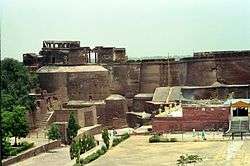Qila Mubarak



Qila Mubarak (Punjabi: ਕ਼ਿਲਾ ਮੁਬਾਰਕ, Hindi: क़िला मुबारक, Urdu: قلعہ مبارک), is a historical monument in the heart of the city of Bathinda in Punjab, India. It has been in existence from 90-110 AD in its current place. It was here that Razia Sultan, the first woman to take charge of the Delhi throne was incarcerated on her defeat and dethroned. The bricks of the fort date back to the Kushana period when emperor Kanishka ruled over Northern India/Bactria. Raja Dab, along with emperor Kanishka, is believed to have built the fort.
History


| Year | Event |
|---|---|
| 50,000 BC | Stone tools such as the hand axe were developed in northern ancient India; artifacts have been found in the modern Bathinda district. |
| 40,000 BC | People begin living in man-made shelter huts in northern Punjab and central Asia (Bactria) |
| 7000 BC | Evidence of people growing barley in this area and raising sheep, goats. People begin living in mud-brick dwellings in villages; some of which are still in existence. |
| 5500 BC | Inhabitants learn to make pottery from burnt clay, a technique that is scarce but still alive today. |
| 3000 BC | Farming villages begin appearing in the Bathinda area, most of which still exist today. |
| 2600 BC | Farmers in the area make use of the plough; exactly as it is still used in some Bathinda areas today. |
| 1500 BC | Cities of the area are abandoned but the rural villages thrive and survive; Indo-Aryans arrive in the area. |
| 800 BC | Indo-Aryans spread in the area and begin clear-cutting forests |
| 600 BC | Area inhabitants begin use of elephants in warfare. |
| 125 BC | A Scythian tribe known as Sakas invaded Punjab from Baluchistan and Sind. |
| 15 AD | The Kushan Kingdom was restored in the area. |
| 90-110 AD | Emperor Kanishka and Raja Dab built it. |
| 179 AD | Bathinda town was established by Bhatti Rao. |
| 1004 AD | Sultan Mahmud of Ghazni captured it. |
| 1045 AD | Pir Hazi Rattan settled here for meditation. |
| 1189 AD | Sultan Mohammed Ghori captured it. |
| 1191 AD | Emperor Prithvi Raj Chauhan recaptured it. |
| 1240 AD | Razia Sultan imprisoned here. |
| 1515 AD | Guru Nanak Dev visited this place. |
| 1665 AD | Guru Teg Bahadur visited this place. |
| 1705 AD | Guru Gobind Singh visited this place. |
| 1835 AD | Maharaja Karam Singh built a Gurdwara here. |
Fort repairs

Currently, a team working with the Akal Society of America, after conducting an extensive two year survey of the site has submitted a proposal of repairs to the Archaeological Survey of India (ASI). The proposed repair work will be funded by external funds provided by the ASA though the former Chief Minister, Captain Amarinder Singh, announced a government contribution of Rs. 12,500,000 (US$275,000) for Qila Mubarak's repair on June 21, 2005 at a ceremony held to mark the tercentenary celebrations of Guru Gobind Singh's visit to the fort. While awaiting final approval (which as been granted on the state level in Punjab, but not yet by the ASI), minor internal repairs are in progress at a slow pace. As on 20-02-2011, the fort is closed for repair work. While visiting it is advised to check beforehand.
This fort is extra ordinary in its exitance, currently under Archaeological survey of India. The repair work has been finished and the fort is now there to welcome tourists.
When Babur came in India for the first time, he came here with cannons. Four of them are here in this fort that are made up of an alloy of silver,gold,copper and iron.
External links
| Wikimedia Commons has media related to Qila Mubarak. |